Understanding the Issue of Flies in Your Home
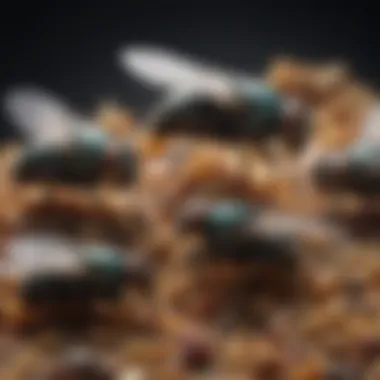
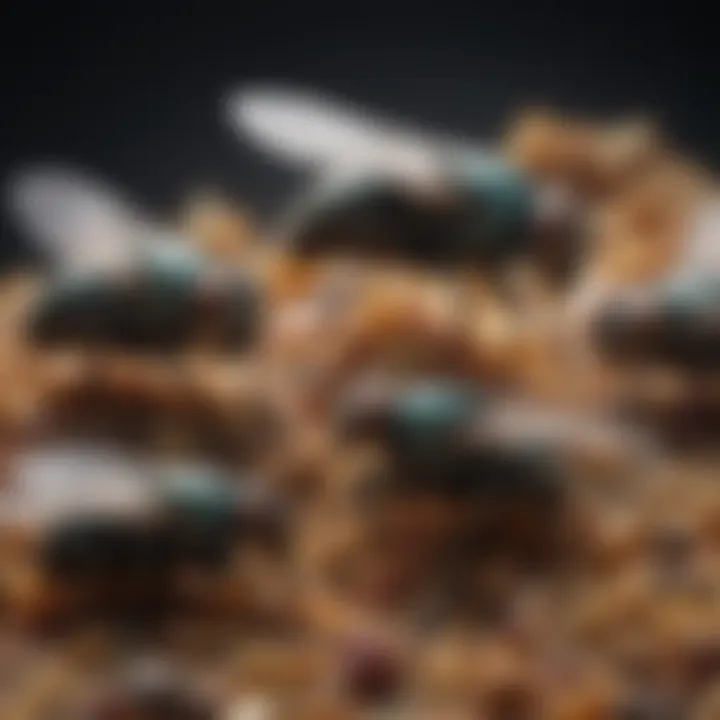
Intro
Flies are more than just an annoying presence in our homes; they pose a real challenge to our living spaces. Understanding why they multiply and how to manage them can protect both our homes and our health. This article offers insights into the biological factors that lead to infestations and explores effective prevention and control strategies.
Understanding Pests
Definition of Pests
Pests are organisms that adversely affect human health, comfort, or property. Flies, in particular, can be particularly troublesome as they are known for breeding quickly and in significant numbers. Knowing what constitutes a pest helps in identifying and addressing the problem effectively.
Importance of Pest Identification
Correctly identifying the species of flies is crucial. Common household flies include the house fly, fruit fly, and drain fly, each requiring different management approaches. By recognizing their characteristics, homeowners can tailor their interventions more effectively.
Prevention Techniques
Home and Garden Preventative Measures
Implementing measures in your home and garden can significantly reduce fly populations. Here are several key strategies:
- Keep trash bins sealed and clean.
- Regularly dispose of spoiled food and organic waste.
- Use screens on windows and doors to block entry.
- Maintain a tidy garden to eliminate potential breeding sites like standing water or decaying plants.
Seasonal Prevention Tips
Flies are often more prevalent during warm months. Seasonal strategies include:
- In spring, inspect and repair any potential entry points.
- In summer, ensure waste is not left exposed outdoors.
- In fall, clean areas where flies can congregate, such as compost bins.
Eco-Friendly Pest Control Solutions
Overview of Sustainable Practices
Adopting eco-friendly solutions can minimize reliance on harsh chemicals. Here are some methods:
- Use essential oils like peppermint or lavender, known to deter flies.
- Implement traps made from household ingredients, like vinegar and dish soap, to lure and eliminate them.
Natural Remedies and Their Effectiveness
Natural remedies can be effective against flies. Some popular options include:
- Vinegar traps: A simple mixture of apple cider vinegar and soap captures flies drawn to the scent.
- Peppermint oil: This not only has a pleasant aroma but also acts as a deterrent.
Staying proactive in preventing fly infestations is essential for maintaining a clean and healthy living environment.
As you delve into these strategies, remember that understanding and action are crucial in managing any pest issue at home. A thoughtful approach can lead to considerable improvements in both comfort and cleanliness.
Intro
The issue of flies multiplying in homes is more than just an inconvenience; it is a situation that can lead to serious health risks and hygiene concerns. Houseflies are not merely a nuisance. They can contaminate food, introduce pathogens, and affect the overall quality of living in a household. As the global population continues to grow, so does urban living, which increases the chances of encountering pest infestations.
Understanding the importance of this topic equips homeowners with necessary knowledge. This article discusses various species of flies commonly found in homes, their behavior, and the environmental conditions that foster their proliferation. By knowing the causes and conditions for fly infestations, individuals can make informed decisions when addressing this issue.
Key aspects such as sanitation, structural integrity of homes, and seasonal variances are crucial in grasping why flies are drawn indoors. Addressing these aspects leads to effective prevention and control measures. For homeowners, this information is indispensable, as it enhances their ability to maintain a clean and healthy living environment.
The Relevance of Fly Infestations in Homes
Fly infestations can drastically diminish our quality of life. Flies are vectors for various diseases and can easily contaminate food sources, making them significant health hazards. The proliferation of these pests often correlates with poor sanitation practices or unnoticed structural damages in the home. Furthermore, some flies, such as fruit flies, are attracted to ripe fruits and vegetables, which can directly affect the food we consume.
Having a clear understanding of the relevance of these infestations helps house owners and residents prioritize their living spaces. It leads to more honest conversations about hygiene and safety, prompting individuals to take preventative measures before infestations become overwhelming. This relevance underlines why the topic deserves attention and action.
Objectives of the Article
This article aims to provide a comprehensive overview of fly infestations, covering several critical objectives:
- To outline the life cycle and reproductive patterns of common species of flies, such as the Common House Fly, Fruit Fly, and Drain Fly.
- To identify the primary causes of infestations, including sanitation issues, structural deficiencies, and environmental factors.
- To discuss the health risks associated with fly presence, including potential disease transmission.
- To present effective preventive measures and control methods that can be implemented by homeowners.
- To offer eco-friendly solutions for managing existing fly populations.
Through these objectives, the article seeks to empower readers with knowledge and practical steps to mitigate fly infestations effectively. This knowledge is essential for enhancing household hygiene, promoting health, and protecting the well-being of residents.
"Knowing the enemy is half the battle. Understanding fly behavior and habitats is crucial for effective pest management."
By imparting this knowledge, the article structures a path toward a cleaner and healthier home environment.
Understanding Flies and Their Behavior
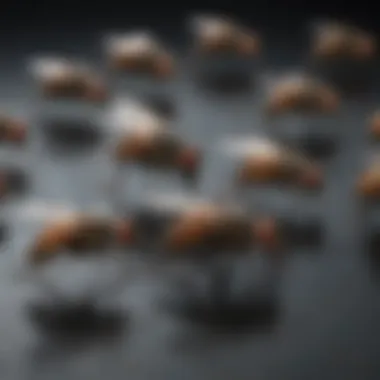
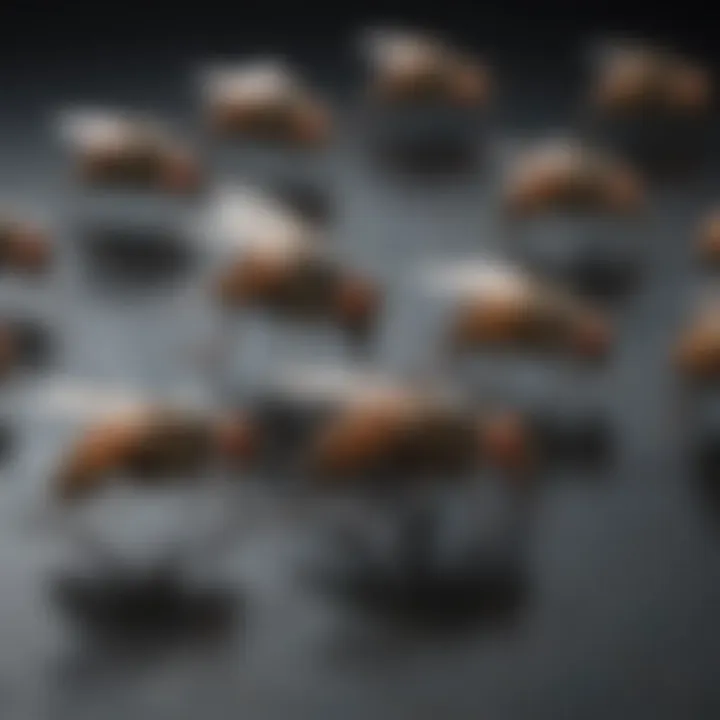
Understanding the behavior of flies is crucial for managing their presence in homes. This section looks at the underlying biological principles and interactions that lead to infestations. By knowing how these insects live and reproduce, homeowners can better recognize the signs of infestation and implement effective measures.
The life cycle of a fly gives insight into how quickly populations can explode. Flies mature from egg to adult rapidly, meaning that a small infestation can quickly become a larger problem. Understanding their reproductive patterns reveals when and how flies breed. Knowing these elements can greatly help in planning appropriate response strategies to control and prevent further infestations.
Life Cycle of Common House Flies
The life cycle of common house flies is short and efficient. It encompasses four stages: egg, larva, pupa, and adult. A female fly can lay hundreds of eggs within a few days. These eggs hatch into larvae, or maggots, within 24 hours under optimal conditions.
The larval stage lasts several days, during which the maggots feed voraciously on organic matter. After feeding, they pupate. This pupa stage can last up to a week, where transformation into adult flies occurs. Once they emerge as adults, they are capable of reproduction within a short time. This rapid cycle is the primary reason why fly populations in homes can grow quickly.
"Understanding the life cycle of house flies is vital for effective pest control and prevention strategies".
Reproduction Patterns
Fly reproduction is often driven by environmental factors. They prefer warm, moist areas with abundant food sources. Areas like kitchens, garbage disposals, or compost bins are particularly attractive to them. Adult flies are not picky and will breed on various materials, including food scraps, organic waste, and even animal excreta.
Flies tend to reproduce in masses. Female flies can mate shortly after emerging and continue to lay eggs for several weeks. The high rate of reproduction contributes to the rapid increase in their numbers, making preventive measures essential. By managing waste and addressing sanitation issues, homeowners can disrupt these reproduction patterns, thereby controlling the fly populations.
Species of Flies That Invade Homes
Understanding the species of flies that commonly invade residential spaces is crucial for effective pest management and prevention. Each species exhibits distinct behavioral patterns, preferences, and reproductive habits, which can influence the methods employed for their control. By identifying the specific flies present in a home, homeowners can tailor their strategies to target the source of the infestation effectively. This section provides an overview of three common species that often become problematic: the common house fly, fruit fly, and drain fly. Knowing their characteristics, reproduction, and attraction can significantly assist in mitigating their numbers and ensuring a healthier living environment.
Common House Fly
The common house fly, scientifically known as Musca domestica, is perhaps the most recognizable of all fly species. It thrives in various environments, often found in urban settings. House flies are attracted to human activity, primarily due to food waste and garbage. Their adult stage is usually gray in color, with four black stripes along the thorax.
- Habitat: They prefer breeding in organic materials that can provide sustenance for their larvae.
- Reproduction: A female house fly can lay up to 500 eggs during her lifespan, typically in clusters of about 120 to 150. These eggs hatch within a day, enabling rapid population growth.
- Health Risks: House flies are notorious for transferring pathogens, as they can land on decaying matter and pick up harmful bacteria, which they later deposit on food surfaces.
Understanding the life cycle and behavior of the common house fly is paramount for developing effective control measures in homes.
Fruit Fly
The fruit fly, or Drosophila melanogaster, is another species that can infiltrate homes, particularly in kitchens and areas where food is stored. These small, tan or brown flies are particularly attracted to ripening and fermenting fruits.
- Habitat: They thrive in places with access to overripe or rotting produce, and they can quickly multiply if conditions allow.
- Reproduction: Female fruit flies can lay around 500 eggs within days in fruit or moist organic materials. The larvae emerge quickly, further complicating infestations.
- Attraction: They are generally attracted to sugary substances, spoilage, and fermenting foods, making proper food storage and waste management crucial in combatting fruit fly populations.
Their rapid life cycle, combined with their attraction to common household items, makes fruit flies a persistent nuisance.
Drain Fly
Finally, the drain fly, also known as Psychoda alternata, is less visible but equally problematic. These tiny, moth-like flies are known to breed in organic matter that accumulates in drains, sewer lines, and other moist areas.
- Habitat: Drain flies prefer damp environments where organic debris is present, deriving nourishment for both their larvae and adult forms.
- Reproduction: Female drain flies can lay up to 300 eggs in a batch. Their lifecycle, from egg to adult, can occur in as little as a week under optimal conditions.
- Health Concerns: While drain flies are less directly harmful than house flies, their presence can indicate underlying sanitation issues that require attention.
Learning about the drain fly’s attributes helps homeowners address potential breeding sites and maintain cleaner environments.
Understanding the specific species of flies in your home is vital for tailored pest management. This awareness enables more effective intervention, reducing the possible health risks associated with infestations while improving overall hygiene and comfort.
Each of these fly species plays a role in the broader context of home infestations. Recognizing their characteristics is a significant step toward effective management and prevention.
Causes of Fly Infestations in Homes
Understanding the causes of fly infestations in homes is crucial for both prevention and control. Flies do not appear without reason; they are attracted to specific conditions that support their survival and reproduction. Identifying the underlying factors can help homeowners address infestations more effectively. This section will address sanitation issues, structural problems, and environmental factors that play a part in attracting flies, thus empowering readers to take proactive measures against these pests.
Sanitation Issues
Sanitation is a primary factor contributing to fly infestations. Flies are often drawn to areas with decaying organic matter, unclean surfaces, or standing water. Kitchen waste such as fruit peels, food scraps, and spills can become breeding grounds for these insects. Failure to regularly remove waste or clean surfaces can lead to significant fly populations.
Here are some key points to consider:
- Regular Cleaning: Frequent cleaning of kitchen and dining areas helps eliminate potential food sources for flies. Pay special attention to spills and sticky residues that may attract flies.
- Proper Waste Management: Utilization of sealed trash cans is vital. Open or improperly managed trash cans emit odors that lure flies. Regularly dispose of waste, especially organic materials.
- Food Storage Practices: Ensure that food is stored in airtight containers. This reduces access for flies and helps in keeping your home sanitary.
Keeping a clean house is the best way to support fly prevention. - Source: en.wikipedia.org
Structural Problems
Structural faults in homes can create conducive environments for flies. Cracks, gaps, and holes in walls or windows provide entry points for these pests. They can quickly find their way inside, especially if they are attracted to the odors emanating from within.
Consider the following:
- Sealing Openings: Inspect your home for any openings. Weatherstripping and caulking can effectively seal small gaps that allow flies to enter.
- Screens on Windows: Installing tight-fitting screens can prevent flies from entering while allowing ventilation.
- Maintenance of plumbing: Leaky pipes or stagnant water can create ideal breeding sites. Regular plumbing checks can help mitigate this issue.
Environmental Factors
The surrounding environment can significantly influence fly behavior. Factors such as proximity to waste, breeding sites in nearby areas, and even seasonal changes can contribute to infestations.
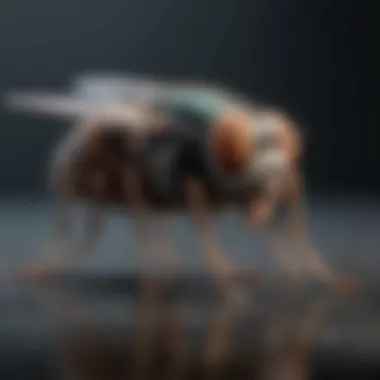
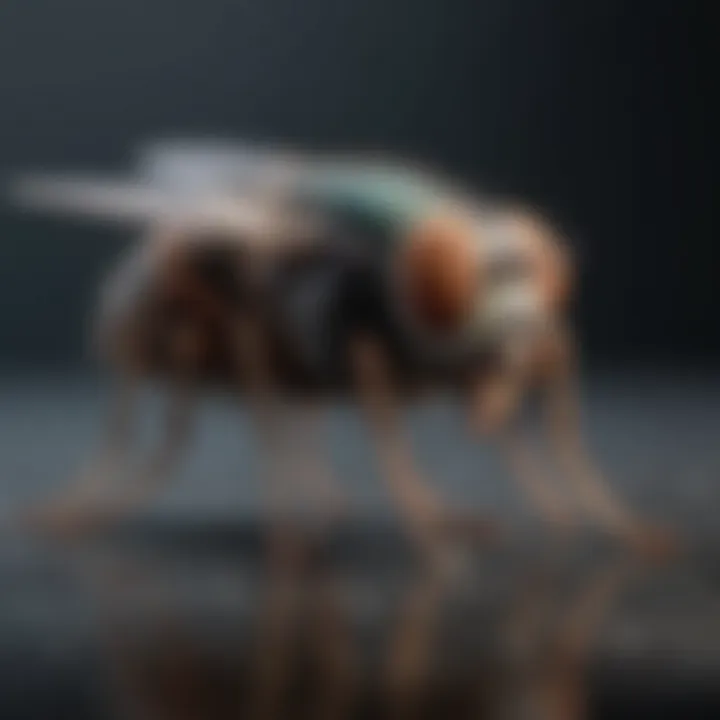
Key considerations include:
- Landscaping Maintenance: Compost piles and piles of leaves can attract flies. Keeping gardens tidy and ensuring proper disposal of yard waste can deter flies.
- Location Awareness: Homes that are close to animal farms or waste disposal sites may face increased fly activity. Being aware of your location can help in proactively managing potential infestations.
- Seasonality: Flies are more prevalent during warm months. This means additional caution is needed during these times to minimize conditions that may attract them.
By addressing sanitation issues, structural problems, and environmental factors, homeowners can significantly reduce the risk of fly infestations. Understanding these causes is a strong first step toward creating a fly-free home.
Impact of Fly Infestations
The significance of understanding the impact of fly infestations in homes cannot be understated. Flies are not merely a nuisance; they impose real health risks and contribute to economic and aesthetic concerns among homeowners. A comprehensive grasp of these issues enables families to take preventive action and mitigate potential hazards effectively. The presence of flies may reflect underlying sanitation problems or structural vulnerabilities, further highlighting the essential need for evaluation and intervention.
Health Risks Associated with Flies
Flies are carriers of various pathogens that can adversely affect human health. Common house flies, for instance, are known to spread diseases such as salmonella, E. coli, and even cholera. They traverse unsanitary surfaces and can deposit harmful microorganisms onto food and kitchen surfaces. This contamination poses a severe health threat.
Some of the diseases linked to fly infestations include:
- Gastroenteritis: Often caused by bacteria that flies transmit, leading to severe digestive issues.
- Diarrheal diseases: Flies can infect food with pathogens, causing severe gastrointestinal problems.
- Conjunctivitis: Flies landing on eyes can introduce bacteria, resulting in eye infections.
Managing these health risks requires constant vigilance. Regular sanitation, coupled with understanding which species of flies are most prevalent, can drastically reduce transmission chances.
Economic and Aesthetic Concerns
The presence of flies also brings about economic and aesthetic challenges. A home plagued with flies can appear unkempt and undesirable, creating discomfort among residents. The perception of cleanliness is crucial, particularly for families that often have guests or those looking to maintain a welcoming environment.
From an economic viewpoint, fly infestations can lead to significant costs:
- Food spoilage: Flies can spoil food by introducing pathogens, leading to financial loss.
- Pest control expenses: Ongoing infestations often require professional pest control services, incurring additional costs.
- Loss of property value: Homes with consistent fly problems may deter potential buyers, thus affecting the market value.
In summary, understanding the health risks and economic impact associated with fly infestations enables homeowners to appreciate the need for preventive measures and timely interventions. This knowledge is crucial in fostering a safe and hygienic living environment.
Preventive Measures Against Fly Infestations
Preventive measures against fly infestations are vital for maintaining a healthy living environment. Flies can reproduce quickly, making it essential for homeowners to implement effective strategies to minimize the risk of an infestation. These measures not only help to control the fly population but also enhance the overall cleanliness and comfort of the home. The emphasis here is on proactive steps that can be taken before an infestation occurs, which is often more effective and less costly than dealing with a full-blown problem later.
Sanitation Practices
Proper sanitation is the cornerstone of effective fly prevention. Flies are attracted to food sources, waste, and filth. Therefore, keeping living spaces clean is essential for reducing their appeal. Regularly dispose of garbage and ensure that bins are tightly sealed to prevent access. Countertops should be cleaned frequently, especially after food preparation, to eliminate any crumbs or residues that could lure flies.
Additionally, consider the following sanitation practices:
- Store food in airtight containers.
- Clean pet food dishes after pets are done eating.
- Empty trash cans regularly and sanitize them to remove odors.
- Maintain cleanliness in kitchens and dining areas.
Implementing these routines not only discourages flies but also enhances the overall hygiene of your home.
Home Maintenance Tips
Maintaining your home is equally important in preventing fly infestations. Structural issues can create entry points for flies and hideouts for breeding. Inspect your home regularly for any cracks or gaps in walls, windows, and doors. Repair any structural flaws promptly to minimize the chance of flies entering.
Key maintenance actions include:
- Use caulk or weather stripping to seal gaps around windows and doors.
- Ensure that window screens are intact, with no holes or tears.
- Keep drains clean and free from organic matter.
- Regularly check for leaks and standing water, which can serve as breeding grounds.
By prioritizing these maintenance tasks, you can complement your sanitation efforts, creating a less appealing environment for flies.
Using Screens and Seals
Installing screens and using seals on doors and windows are effective barriers against flies. These physical barriers prevent flies from entering your house while allowing fresh air to circulate. Choose fine mesh screens for windows to ensure flies do not find a way through.
Consider the following points:
- Make sure all doors have door sweeps or thresholds to close off gaps.
- Regularly check screens for damage to ensure complete protection.
- In high-risk areas, consider screen doors as an additional line of defense.
By combining screens and effective sealing methods, you can further fortify your home against potential fly invasions.
"An ounce of prevention is worth a pound of cure."
Taking these preventive measures seriously can lead to significant benefits. Homeowners who actively engage in proper sanitation and maintenance practices not only reduce the likelihood of fly infestations but also promote a more pleasant living environment. Through diligence and attention to detail, the majority of fly-related issues can be avoided.
Control Methods for Existing Infestations
Dealing with fly infestations in the home is often a complex challenge that requires a multi-faceted approach. Control methods for existing infestations are critical because they address immediate issues while also laying the groundwork for long-term management. Effectively reducing fly populations can enhance not only the comfort of the home environment but also the overall health and well-being of its inhabitants. This section explores various control methods available, including traps and baits, chemical solutions, and natural approaches.
Traps and Baits
Using traps and baits can be an efficient way to tackle fly infestations. Different types of traps are readily available that cater to various species of flies. Sticky traps, for instance, can catch common house flies and fruit flies. Placing them in strategic locations such as near windows, doors, and kitchens can significantly reduce fly numbers.
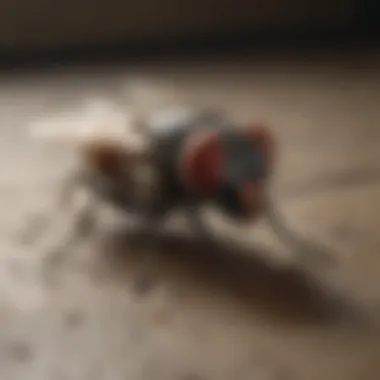
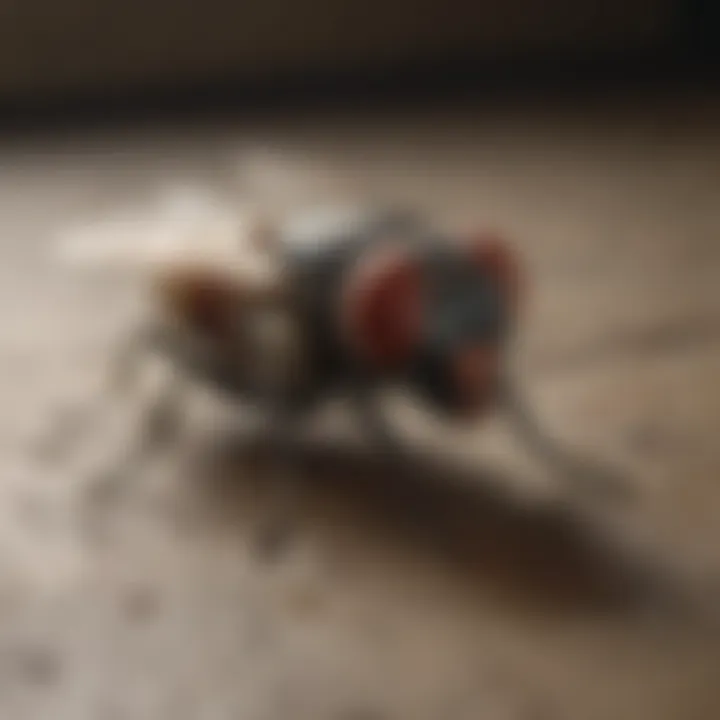
Effective and timely placement of traps is essential for optimal results.
Baits also serve to lure flies into traps, enhancing their effectiveness. Chemical baits can attract flies through odor. It is important to ensure that these traps do not pose risks to pets or children. Therefore, selecting the right type of trap based on the species of fly is crucial for safe and effective management.
Chemical Approaches
Chemical methods effectively eliminate flies, although they require careful consideration. Insecticides designed for fly control can offer quick results. However, it is vital to follow the instructions diligently to avoid health hazards. Some chemicals may leave residue or disrupt indoor air quality, which raises concerns about their long-term effects.
Homeowners should focus on using products that target specific types of flies. This targeted approach minimizes unnecessary exposure to non-target organisms and can be more cost-effective as well. Always review the safety data sheets and product labels for necessary precautions.
Natural and Eco-friendly Solutions
For those inclined towards safer alternatives, natural and eco-friendly solutions exist to manage fly infestations. Certain essential oils, such as eucalyptus or lavender, can deter flies due to their strong scents. These oils can be used in diffusers or as sprays. Additionally, vinegar traps are a simple yet effective method, utilizing fruit or apple cider vinegar to attract and trap flies.
Incorporating plants like basil or mint around the home can also provide a natural barrier against flies. As they grow, these plants can serve as both a deterrent and an aesthetic enhancement. Taking these eco-friendly measures reflects a commitment not only to home hygiene but also to environmental conservation.
Using a combination of these strategies can provide a comprehensive approach for controlling existing fly infestations, reducing their impact effectively against potential health risks and discomfort.
Long-term Strategies for Fly Management
Long-term management of fly infestations is crucial for keeping homes free from these pests. It goes beyond immediate fixes or quick extermination methods. To truly tackle the problem, homeowners must adopt a holistic approach that includes consistent sanitation and ongoing monitoring. Implementing these strategies decreases the likelihood of recurrence, ensuring healthier living spaces.
Ongoing Sanitation Efforts
Sanitation is the backbone of fly management. Flies are drawn to waste, food residues, and moisture. Maintaining a clean environment can significantly reduce their attraction to your home. Here are some specific efforts one can undertake:
- Regularly clean countertops and surfaces. Ensure there is no food debris.
- Frequently take out garbage. Seal trash bins tightly.
- Keep drains free of organic materials that can rot and attract flies.
- Store food in sealed containers. This practice minimizes the chance of flies getting access to food resources.
Additionally, a deep cleaning schedule every few weeks can help catch any overlooked areas. Pay attention to corners, under appliances, and places often neglected.
Monitoring and Assessment Techniques
Assessing your environment regularly helps in identifying problem areas. Continuous monitoring can alert you to early signs of infestations and avoid larger issues later on. Consider these techniques:
- Visual Inspections: Check for flies regularly. Noting where they gather helps pinpoint potential breeding sites.
- Data Logging: Maintain a log of fly sightings and any sanitation efforts made. This log can highlight seasonal patterns or persistent issues.
- Fly Traps: Install sticky traps to count the number of flies. They provide tangible evidence of fly levels in your home.
- Analyze Breeding Areas: Conduct an assessment in areas like garbage disposals, basements, and food storage to find possible breeding areas and reduce moisture.
Regular monitoring will ensure that any potential fly problems are recognized before they escalate into significant infestations.
Implementing these long-term strategies is vital. This approach not only minimizes the populations of flies but also contributes to a healthier and more hygienic home environment. Homeowners must commit to these practices for sustained effectiveness against fly infestations.
Case Studies on Fly Infestations
Understanding real-life examples of fly infestations can illuminate key aspects of prevention and management. Case studies can provide tangible evidence of how specific strategies have succeeded or failed in controlling fly populations. They emphasize the importance of adaptability and the ongoing need for evaluation in pest management efforts. By analyzing various situations, house owners can learn valuable lessons that can help them avoid pitfalls and adopt effective measures against fly problems.
Successful Management of Fly Populations
In one notable case, a household in suburban Seattle faced a severe infestation of the common house fly. They implemented an aggressive sanitation routine, ensuring that all food remnants were promptly cleaned, and garbage was sealed. Additionally, they installed screens on all windows and doors, reducing the entry points for flies. The results were promising; over a few weeks, the fly population decreased significantly, proving the effectiveness of good hygiene practices and physical barriers.
Another successful strategy was adopted in a restaurant in Chicago. The management started using a combination of traps and natural repellents such as essential oils. This dual approach not only diminished the number of flies but also maintained the aesthetic and health standards required for food establishments. This case emphasizes the need for diverse control measures tailored to specific environments.
Lessons Learned from Infestations
One critical takeaway from various case studies is the impact of continuous monitoring. Many households that failed to control fly populations often did so due to complacency after initial successes. Regular inspections of areas prone to infestations—like kitchens and waste management zones—allow for timely interventions before small problems escalate.
A recurring theme among homes that experienced recurring infestations is a negligence towards structural repairs. Cracks in walls or gaps around windows often serve as inviting entry points for flies. Addressing these issues not only improves overall home maintenance but also acts as a barrier to potential infestations.
Additionally, understanding the biology of flies can help homeowners implement targeted management strategies. One case noted a family who successfully reduced fruit fly populations by removing overripe produce from their kitchen. This illustrates the importance of being vigilant about attractants that can lead to infestations.
"Taking proactive steps and learning from others' experiences can distinguish between a small fly problem and a larger infestation."
By studying these examples, it becomes evident that effective fly management combines rigorous sanitation practices, structural integrity, and an understanding of fly behavior. Monitoring, adaptability, and openness to various control methods contribute to successful population management.
Ending
The conclusion of this article serves as a vital component in synthesizing the various facets of fly infestations discussed throughout. It not only encapsulates the core findings but also underscores the persistent relevance of the topic for homeowners and pest management professionals alike. Understanding fly behavior, the conditions that promote their multiplication, and the consequences of inaction is crucial. This summary reinforces the importance of addressing the issue before it escalates, ensuring a healthier living environment.
Summary of Key Points
In navigating through the different sections of this article, several key points emerge that deserve emphasis:
- Life Cycle and Behavior: Familiarity with the life cycle and reproductive patterns of common house flies, fruit flies, and drain flies helps to identify potential infestations early.
- Causes of Infestations: Sanitation practices, structural weaknesses, and environmental factors all contribute significantly to the likelihood of fly invasions. These causes must be addressed proactively to minimize risk.
- Impact of Infestations: The health risks associated with flies, including the transmission of diseases, alongside the economic and aesthetic consequences, highlight the urgency of effective management.
- Preventive Measures: Implementing consistent sanitation practices, regular home maintenance, and the strategic use of screens and seals can deter flies from entering and proliferating in the home.
- Control and Long-term Strategies: A combination of trapping, eco-friendly solutions, and ongoing monitoring can help manage existing populations and prevent future infestations.
These points provide a framework for effective fly management and underscore the need for vigilance in maintaining a fly-free home.
Future Considerations
Looking ahead, there are several considerations that homeowners should keep in mind:
- Evolving Strategies: The methods for fly control and prevention may evolve as new research emerges. Homeowners should stay updated on the latest findings and adaptations in pest management practices.
- Integration of Technology: Advances in technology may offer innovative solutions for monitoring and controlling pests. Smart traps and apps for tracking infestation levels could become commonplace in future pest management strategies.
- Environmental Impacts: Homeowners should consider the ecological implications of their control measures. Emphasizing natural and eco-friendly options will benefit both residential spaces and the broader environment.
- Community Involvement: Engaging with neighbors can create a community-wide approach to managing fly populations, sharing best practices, and reporting infestations promptly.
By focusing on these future considerations, homeowners can enhance their strategies for combating fly infestations and contribute to a more harmonious living space.



